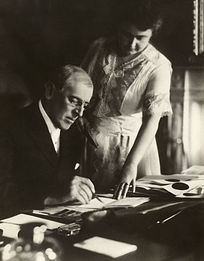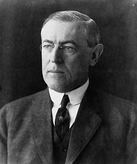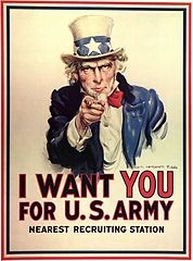Election of 1916 and World War I
|
Profiles
* Political Thought * Colonial Government * Revolution * Constitution * Birth of Party Politics * War of 1812 * James Monroe: "Era of Good Feeling" and Monroe Doctrine * Jacksonian Democracy * Regional Conflict and Compromise * 1860 Election of Abraham Lincoln * Civil War 1861-62 * Civil War 1863-65 * Reconstruction and Impeachment of President Johnson * Gilded Age and Progressive Era * 1912 Election of Woodrow Wilson * 1916 Election and World War I * Women's Suffrage * Depression and 1932 Election of Franklin D. Roosevelt * Prelude to World War II * Pearl Harbor and Mobilization * World War II: European Theater * World War II: Pacific Theater * Atomic Bomb and End of World War II * 1948 Truman-Dewey Election * 1960 Kennedy-Nixon Election * 1964 Johnson-Goldwater Election * Civil Rights Movement * Vietnam: Evolution of the American Role * Vietnam: Kennedy Administration and Intervention * Vietnam: Johnson Administration and Escalation * Vietnam: Nixon, Ford and Fall of South Vietnam * 1968 Humphrey-Nixon Election * Watergate Scandal and Resignation of President Nixon * 1976 Carter-Ford Election * 1980 & 1984 Reagan Elections * Clinton Impeachment * 2000 Bush-Gore Election * War in Iraq * 2008 Obama-McCain Election * 2016 Trump-Clinton Election |
|
 In the first posed photo after his major stroke some nine months before, President Wilson is shown in June 1920 seated at desk in the White House with his wife, Edith Bolling Galt Wilson, standing at his side and steadying a document as her husband signs. Image: Library of Congress In the first posed photo after his major stroke some nine months before, President Wilson is shown in June 1920 seated at desk in the White House with his wife, Edith Bolling Galt Wilson, standing at his side and steadying a document as her husband signs. Image: Library of Congress
During the rest of his second term, the status of Wilson's health continued to be covered up by Mrs. Wilson, who communicated decisions to outsiders which purportedly had been made by him, and by his doctors, who released deceptively optimistic reports. The official White House explanation was that Wilson was suffering from "nervous exhaustion." He gradually recovered from the more severe effects of the stroke, using a wheelchair and cane for a period, but rarely made public appearances and never again fully regained his health.
Women's Suffrage
During his first term, Wilson had been criticized for his lack of support for an amendment to the Constitution granting women the right to vote. He had given tacit support to efforts in the states to grant the franchise in their own constitutions, but had resisted the attempts to enact suffrage on a national basis, which was opposed by several southern states on the ground that it would interfere with states' rights. After the nation entered the war in his second term, however, Wilson came out forcefully for a federal amendment, asking in a speech to Congress, “We have made partners of the women in this war… Shall we admit them only to a partnership of suffering and sacrifice and toil and not to a partnership of privilege and right?” On June 4, 1919, what would become the 19th amendment finally received the votes necessary in the House to be sent to the states for ratification by 36 legislatures; it became effective following Tennessee's approval on August 18, 1920. See also Women's Suffrage Life after leaving office Wilson left office on March 4, 1921, riding to the Capitol with his successor, the Republican Warren G. Harding, who had campaigned aggressively against Wilson's policies. Harding's campaign slogan "A Return to Normalcy" reflected a public sentiment to refocus on domestic concerns after Wilson's ventures into international affairs; Wilson retired with his wife to a home they had purchased in Washington, and was rarely seen in public, but did make a brief radio address on Armistice Day in 1923, later dying at his home on February 3, 1924.
Resources
* Woodrow Wilson (1856–1924) >> Miller Center, University of Virginia * Woodrow Wilson >> PBS * Woodrow Wilson Presidential Library & Museum * Paris Peace Conference-1919 (video) >> History is Happening Education * Presidential Election of 1912 (lesson plan) >> PBS * Woodrow Wilson: Prophet of Peace (lesson plan) >> National Park Service * Teaching With Documents: Political Cartoons Illustrating Progressivism and the Election of 1912 >> National Archives * Woodrow Wilson, "The Pueblo Speech" (25 September 1919) (teaching and learning materials) >> Voices of Democracy, The U.S. Oratory Project |

